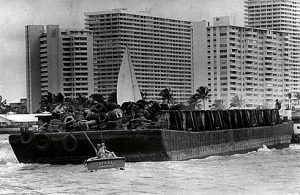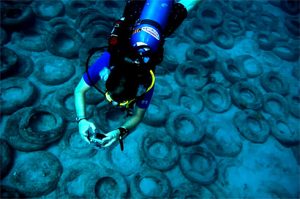Blue Whale in Costa Rica
October 30th, 2012
The invention of tires has made car travel more easier and smoother but when tires are worn out, having an average life span of 50,000 miles, they need to be replaced with new ones. While more and more people are using cars, the quantity of old tires trash each year at junkyards, is also increasing. As old tires are piling up, they have become a good raw material and one of this is an artificial reef made of used tires.

Photo by John Foster
In Florida alone, some 700,000 old tires were clustered in groups and dumped in the sea to become an artificial reef. At first, it proved to be efficient where marine organism has started to take refuge from the artificial structure. But as time goes by, the structure collapse as the nylon and other tying material snapped due to the wear and tear. The scenario was worsened during hurricane season where old tires are scoured by waves and strong tides ending up in natural reefs and up in the beaches.
Well, artificial reefs made out of used tires are not just deployed in Florida, but in other parts of the world especially in areas with high concerns for reef conservation. In fact, Costa Rica has its fair share of using old tires for artificial reef mostly concentrated in the areas of Guanacaste.
Aside from serving as a fish attracting device and refuge for marine critters, its negative effects have overwhelmed what was supposedly a good idea both for waste management and reef conservation. Here are some of the negative effects and reasons why an artificial reef made out of old tires has become a bad idea:
• It collapses and litters the seafloor

Photo by Joe Amon
As water constantly moves, the tying material such as nylon loosens down over the years causing the heavy structure to collapse. Imagine the damage it causes to the marine critters that is supposedly taking refuge to this artificial structure. When the structure collapses, the tires can easily be taken by the waves and tidal flow where some have reported seeing hundreds, if not thousands of old tires washed up along the beach. This event can be worsened during seasons of severe weather condition like hurricanes.
• It damages nearby reef system
Artificial reefs are usually located outside the reef system in a sandy flat bottom. When the structure collapses and loosen up, detached tires from the structure can come in contact and damage a nearby reef. A worst-case scenario would be several detached old tires getting entangled in the reef causing a continuous 24/7 destruction.
• It releases toxins and pollutes the water
Although the composition of a brand-new tires is made differently depending on the manufacturer, there are ingredients that are common in making a tire like black carbon, sulphur, zinc oxide and peroxides. These ingredients are exposed to its environment especially if the tire is already worn out. In the case of artificial reefs, we are not using brand new tires and of course, this is not the logical thing to do. When deployed underwater, the decomposition of worn-out old tires is hastened causing the early release of tire chemicals which are considered toxic to the marine environment. An early manifestation that tire chemicals are starting to pollute the water is the growth, if not, the dominance of marine algae.
There is no such thing as the perfect artificial reef and no artificial structure can replace a natural reef system. But in general, any artificial structure that can closely represent a natural reef can be a good idea. This means, that it should first be solid and heavy enough to withstand the forces of nature especially in an underwater setting. Second, it should not damage nearby ecosystems, not just coral reefs, during the course of its existence. And most importantly, it should not pollute the water which has greater consequences.
 As far as the practice in Costa Rica is concerned, metal and concrete are the best base material for an artificial reef. There are old steel vessels that are accidentally or intentionally sunk to become shipwrecks. Cinder blocks made out of concrete is the popular way to develop an artificial reef system. Aside from being cheap, it can easily be handled and managed from construction, deployment to monitoring.
As far as the practice in Costa Rica is concerned, metal and concrete are the best base material for an artificial reef. There are old steel vessels that are accidentally or intentionally sunk to become shipwrecks. Cinder blocks made out of concrete is the popular way to develop an artificial reef system. Aside from being cheap, it can easily be handled and managed from construction, deployment to monitoring.
To sum it up, artificial reefs using old tires can only be a good idea for waste disposal facilities who can empty their junkyards and storage facilities in exchange for cash and credit for encouraging the concept. But again, we go back to the primary purpose of this travel buddy: “Tires are made for road use and not to become as an ocean waste.
For more information, please click on this related article: https://usatoday30.usatoday.com/news/nation/2007-02-17-florida-reef_x.htm
video courtesy from CBS Evening News
Microscopic view of coral larvae. Coral reefs start its life cycle as a floating organism called zoaea wandering the seas until it reaches a certain time that it needs to ...
The artificial reef project in Costa Rica started in the 1980’s where used tires are bundled together forming a huge underwater structure for corals to attach. But most of the structures failed as the tires get loose over time and was not abl ...
“To dive in a healthy reef”, that’s what most divers dream of. We often use this term to describe how beautiful a dive site can be. But technically, do we really know the definition of a healthy coral reef? In assessing the state of a particul ...